
My Story
My name is Rick Shaw and I am the founder and CEO of Awareity, and the originator of the proven and multi-award-winning “TIPS prevention platform”.
My background includes more than 30 years of real-world business related experience, combined with several years of extensive research. My business experience includes performing numerous types of assessments (risk, threat, information security, physical security, safety, compliance and others) and prevention efforts across many different types and sizes of organizations. My research involves reviewing hundreds of post-incident reports – the facts and findings released after investigations, tragedies and lawsuits. Combined, these efforts have helped me to identify common “gaps, disconnects and missing steps” that expose and explain why so many organizations continue to experience expensive and embarrassing prevention failures.
However, one of the most valuable lessons I ever learned and what helped me truly understand the “return on proactive prevention” started over 40 years ago when I was in 6th grade. As a 6th grader I was a member of the gifted student class and some of our classes were held in the same elementary school where the special education students’ classes were held. One of the students in the special education class was a girl named MJ. I remember students continuously teasing and bullying MJ on the playground and I remember how that relentless teasing would sometimes cause MJ to have terrible seizures. I remember feeling really bad for MJ when she would wake up from her seizure confused and very scared, so I decided I was going to do the right thing and do whatever I could to prevent the other students from teasing and bullying MJ. I also remember getting my teacher involved so he could help me prevent the other students from harassing MJ. I remember explaining to the other students that we need to stick up for MJ and prevent others from teasing and bullying her which would prevent the seizures. The good news is we were successful and we prevented most of the teasing and bullying. I also remember how MJ appreciated my efforts so much that she would chase me around the playground to give me a hug or kiss and called me her boyfriend!
For the next 6 years when I would see MJ, we would smile and say hi as we both continued to experience a valuable “return on proactive prevention”. But the “return on proactive prevention” did not stop when we graduated from high school. 25 years later when I walked into our high school reunion, there was MJ and we both got a big smile on our face and we gave each other a hug and MJ introduced me to her husband. It was great to see how well MJ was doing and that we were both still experiencing a valuable “return on proactive prevention”.
But the “return on proactive prevention” did not end at the high school reunion…a little over a year later I received a very cool Happy Birthday notification from our class reunion website …it was from MJ!
The “return on proactive prevention” offers amazing results and I will never forget the valuable lessons I learned from my real-life experiences with MJ. The positive feedback and feelings of accomplishment motivated me to seek out effective proactive prevention solutions that could help others take action and experience similar “return on proactive prevention” results.
How were the “6 Essential Steps to Proactive Prevention” identified? Through the culmination of over 40 years of “return on proactive prevention” experiences, business experiences and extensive research.
The “6 Essential Steps to Proactive Prevention” are:
-
Awareness – ongoing and updated at the Individual Level with accountability and measurability
-
Collect the Dots – central secure platform to collect anonymous incident reports of pre-incident indicators, concerning behaviors, suspicious activities, incidents and more
-
Assess the Dots – threat assessment, behavioral assessment, collaboration, investigations and much more
-
Connect the Dots – secure information sharing and connecting all the right information with the right people in the right places at the right times so the right people can do the right things
-
Intervention & Monitoring – intervention plans for at-risk individuals and at-risk situations, documenting, continuous monitoring, follow ups, escalations and much more
-
Prevention – immediate and ongoing involvement with at-risk individuals, review of failed efforts, review of successful protocols in employee safety, public safety, student safety, asset preservation, lessons learned and much more
The “6 Essential Steps to Proactive Prevention” have been validated over and over by data from:
-
Hundreds of post-incident reports exposing gaps and steps that were not followed resulting in prevention failures.
-
Real-world successes from schools, colleges, government, financial, health care and others
Each of the “6 Essential Steps to Proactive Prevention” will be featured in an upcoming series of blogs.
If you would like to share your own “return on proactive prevention” story or if you would like to learn how a proven proactive prevention platform is helping leading organizations more effectively achieve the 6 essential steps, send your story or request to info@awareity.com.
To continue to Part 2, click here.